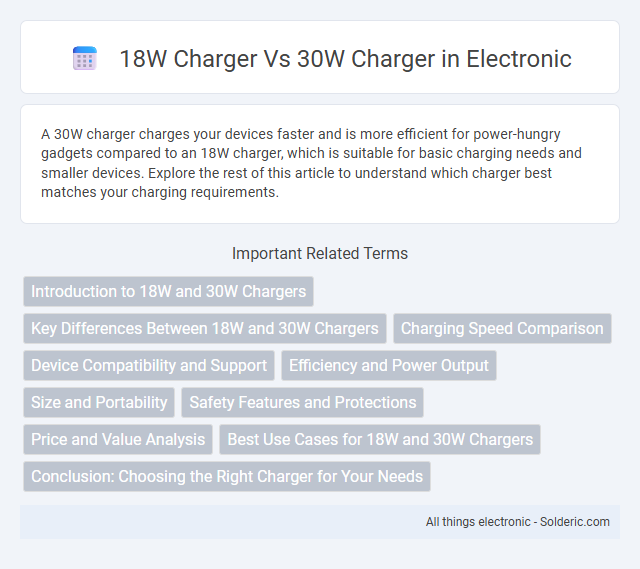A 30W charger charges your devices faster and is more efficient for power-hungry gadgets compared to an 18W charger, which is suitable for basic charging needs and smaller devices. Explore the rest of this article to understand which charger best matches your charging requirements.
Comparison Table
| Feature | 18W Charger | 30W Charger |
|---|---|---|
| Power Output | 18 Watts | 30 Watts |
| Charging Speed | Standard fast charging | Faster charging, ideal for larger devices |
| Supported Devices | Smartphones, small tablets | Smartphones, tablets, laptops |
| Compatibility | USB Power Delivery, Quick Charge | USB Power Delivery, Quick Charge, compatible with higher watt devices |
| Charging Time (Example) | Phone battery (3000mAh): ~1.5 hours | Phone battery (3000mAh): ~1 hour |
| Portability | Compact and lightweight | Moderate size, slightly heavier |
| Price | Affordable, budget-friendly | Higher price, better performance |
Introduction to 18W and 30W Chargers
18W and 30W chargers differ primarily in their power output, with 18W chargers delivering moderate charging speeds suitable for most smartphones and small devices, while 30W chargers provide faster charging ideal for tablets, larger smartphones, and some ultrabooks. The increased wattage in 30W chargers allows for quicker energy transfer, reducing overall charging time significantly compared to 18W options. Both chargers typically utilize USB Power Delivery protocols, but the 30W charger supports higher voltage and current levels to achieve enhanced performance.
Key Differences Between 18W and 30W Chargers
An 18W charger delivers slower charging speeds compared to a 30W charger, making the latter more efficient for quickly powering up compatible devices. The 30W charger supports faster power delivery, which reduces your device's charging time significantly, especially for smartphones and tablets with larger batteries. Choosing a 30W charger ensures enhanced charging performance, making it ideal for users seeking speed and convenience.
Charging Speed Comparison
A 30W charger delivers almost twice the power output compared to an 18W charger, significantly reducing your device's charging time. While an 18W charger might take around 100 minutes to fully charge a smartphone, a 30W charger can achieve the same in approximately 50-60 minutes. Choosing a higher wattage charger ensures faster charging speed, which is especially beneficial for quick power top-ups during your busy day.
Device Compatibility and Support
An 18W charger typically supports most smartphones, tablets, and small electronic devices that use USB Power Delivery (USB-PD) or Quick Charge standards, making it compatible with a wide range of everyday gadgets. A 30W charger is designed to charge not only smartphones and tablets but also more power-hungry devices like lightweight laptops, larger tablets, and some gaming devices, providing faster charging speeds and broader compatibility. Devices requiring higher wattage, such as ultrabooks with USB-C charging, benefit from the 30W charger's enhanced power output, ensuring efficient and reliable charging without device strain.
Efficiency and Power Output
A 30W charger delivers higher power output, enabling faster charging times compared to an 18W charger, which is more suited for devices with lower power demands. Efficiency between the two varies, with 30W chargers typically employing advanced circuitry to reduce energy loss and heat generation during charging. Your device's compatibility with higher wattage affects overall charging performance, making it essential to match the charger to your specific power requirements.
Size and Portability
An 18W charger is typically more compact and lightweight compared to a 30W charger, making it easier to carry and ideal for travel or daily use. The smaller size of 18W chargers fits comfortably in pockets or small bags, enhancing portability without compromising convenience. In contrast, 30W chargers often have a bulkier design to accommodate higher power output and heat dissipation, which may impact their portability.
Safety Features and Protections
18W chargers typically include basic safety features like over-current, over-voltage, and short-circuit protection to prevent device damage during standard charging scenarios. 30W chargers often incorporate advanced safety mechanisms such as temperature regulation, surge protection, and intelligent power delivery management to handle higher power loads more safely. Choosing a charger with comprehensive safety certifications, like UL or CE, ensures reliable protection regardless of wattage.
Price and Value Analysis
An 18W charger typically offers a lower upfront cost, making it a budget-friendly option for basic charging needs, while a 30W charger provides faster charging speeds at a higher price point. The value of a 30W charger becomes apparent for users with devices supporting fast charging, as it reduces downtime significantly compared to 18W chargers. Your choice depends on balancing the cost against the benefits of quicker power delivery and enhanced convenience.
Best Use Cases for 18W and 30W Chargers
An 18W charger is ideal for smartphones and smaller devices, providing efficient charging without overheating or excessive power consumption. A 30W charger better suits tablets, fast-charging laptops, and devices with larger batteries that require higher wattage for quicker recharge times. Your choice depends on device compatibility and charging speed needs, with 18W optimizing energy use for everyday devices and 30W delivering enhanced power for demanding electronics.
Conclusion: Choosing the Right Charger for Your Needs
A 30W charger delivers faster charging speeds, ideal for devices with larger batteries or quick power top-ups, while an 18W charger suits everyday use and smaller devices. Your choice depends on device compatibility and charging habits, balancing speed with portability and cost. Opting for the right charger ensures efficient energy use and prolongs your device's battery lifespan.
18W charger vs 30W charger Infographic

 solderic.com
solderic.com